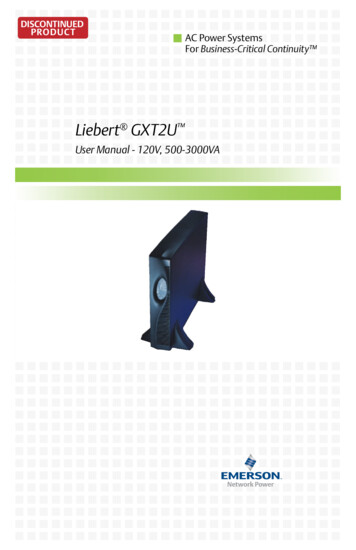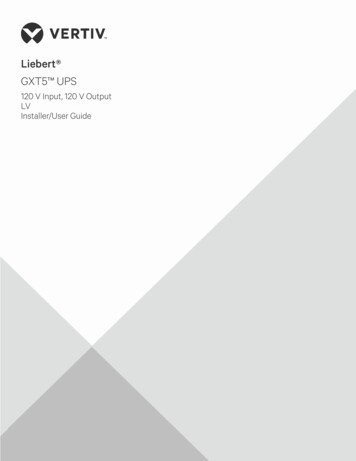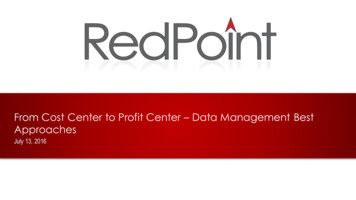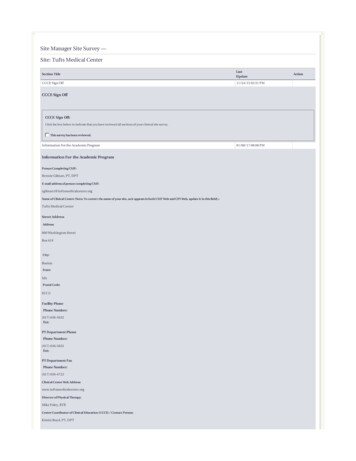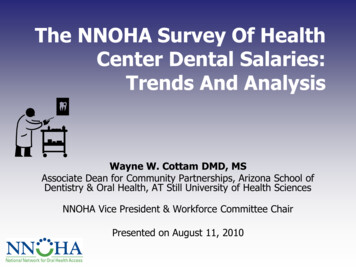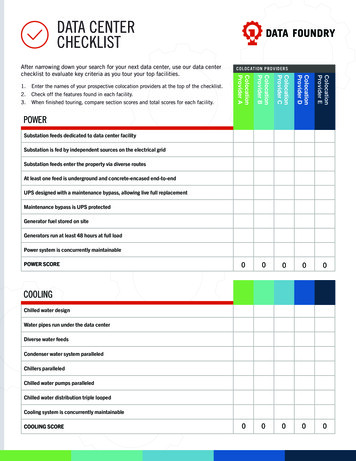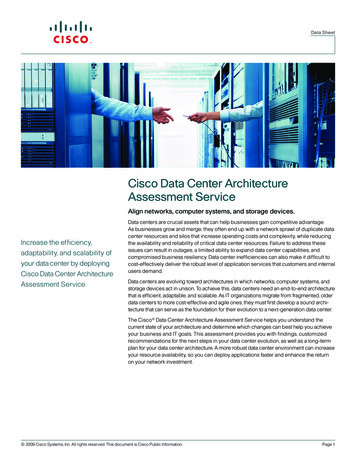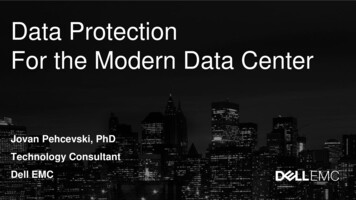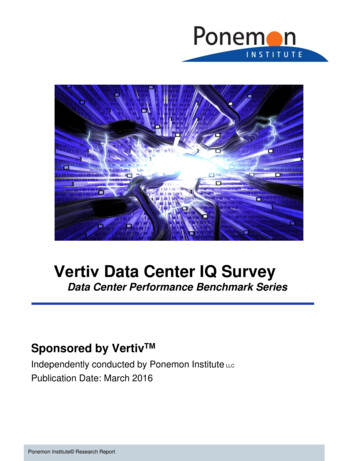
Transcription
Vertiv Data Center IQ SurveyData Center Performance Benchmark SeriesSponsored by VertivTMIndependently conducted by Ponemon Institute LLCPublication Date: March 2016Ponemon Institute Research Report
Vertiv Data Center IQ QuizConducted by VertivTM and Ponemon Institute March 2016I. Overview . 3II. The Data Center IQ QuizCost Control. 4Productivity . 7Speed of Deployment . 10Application Availability . 13Risk Management . 16III. Aggregate Results . 17Knowledge Questions . 17IV. Method and Participant Profile . 22V. Caveats . 25Sponsored by VertivTMPonemon Institute Research ReportPage 2
Section I: OverviewPonemon Institute and Vertiv are pleased to present the results of the first Vertiv DataCenter IQ Quiz, part of the Data Center Performance Benchmark Series, which providesan industry-wide perspective on Availability, Security, Productivity, Cost and Speed ofDeployment. The purpose of this study is to determine the domain knowledge of datacenter personnel while also collecting data on application of best practices and currentoperating conditions within participants’ data centers.Individuals located in the North American data center management and IT operationscommunity were invited to participate in a survey consisting of 37 objectively framedquestions. These questions were organized as follows: Twenty-five knowledge questionsTwelve general, descriptive questions about current data center practicesAll questions were developed by Vertiv and draw from various sources, including TheUptime Institute, The Green Grid, Vertiv’s Data Center Users’ Group and the IEEE.They are divided into five categories that align with the key issues data centersprofessionals face: Maintaining availabilityControlling costMitigating riskImproving productivityIncreasing speed of deploymentThe fielding of the survey and compilation of results were independently conducted byPonemon Institute. The quiz was designed to be challenging and proved to be so for the570 participants who completed it. On average, participants achieved 9.4 correctresponses out of 25 total quiz questions. Only seven respondents achieved a perfectscore.When viewed by functional role, Data Center Management and Facilities Managementperformed the best, averaging 11 correct responses, while IT Management performedthe worst with an average of seven correct responses. Participants with data centerslarger than 10,000 square feet scored better than those with smaller data centers andparticipants in the 30-49 age range scored better than those younger and older. In termsof vertical industries, participants from colocation companies performed the best with anaverage score of 12, followed closely by cloud/hosting and financial services with 11.Sponsored by VertivTMPonemon Institute Research ReportPage 3
Section II: The Data Center IQ QuizNote: Correct answers are shown in boldCost Control1. What does PUE stand for? Power usage effectiveness . 32%Power usage efficiency . 26%Processing usage efficiency . 20%Processing usage effectiveness. 22%While the correct answer—Power Usage Effectiveness—was the number one response provided,it was selected by less than a third of participants. This is surprising considering that PUE hasbecome the de facto measure of data center efficiency. It can be argued that it isn’t necessary toknow what PUE stands for to optimize it; nevertheless, 44 percent of respondents believed thatthe “P” in PUE stands for Processing, which indicates a lack of understanding of what PUE ismeasuring.2. True or False: A PUE calculation includes the lighting of the data center. True . 50% False. 50%According to The Green Grid, which established the PUE metric, “PUE measures the relationshipbetween the total facility energy consumed and the IT equipment energy consumed,” and isexpressed as a ratio of those two numbers. A data center with total energy consumption of 1 MWwith 625 kW of that energy used by IT equipment would have a PUE of 1.6 (1000/625). Energyconsumed by the data center lighting is included in the total facility energy.3. What is your most recent PUE for your primary data center?Sponsored by VertivTMPonemon Institute Research ReportPage 4
The responses to this question demonstrate just how broad the range of PUEs has become in thecurrent environment, where legacy facilities coexist with new high-efficiency data centers: 10percent of respondents had PUEs above 2.0, while 14 percent had PUEs below 1.2. Consider thedifference that means for a 1 MW facility: With a PUE over 2.0, less than 500 kW of availablepower is used by IT equipment, while the same size facility operating with a PUE of 1.2 has 830kW available to power IT equipment. Eighty-seven percent know their PUE but only 50 percentknow what goes into its calculation and 32 percent know what it stands for and.4. What is the average server inlet temperature in your primary data center?The current ASHRAE standard recommends an upper limit of 78 F; however, the majority ofparticipants in the survey (56 percent) stated they are operating below 71 F. According toVertiv, a 10 percent increase in cold aisle temperatures can result in a 20 percent reductionin cooling system energy consumption5. Identify this object. Plug fan . 34%GT fan . 20%Centrifugal fan . 18%Basket fan . 21%Centrifugal diffuser. 7%While this may not seem like an item all professionals involved in data center operations wouldneed to know, facilities professionals should especially be familiar with it as replacing centrifugalfans in data center cooling units with EC Plug Fans reduces cooling unit energy consumption by18-30 percent.Sponsored by VertivTMPonemon Institute Research ReportPage 5
6. What is the formula for converting refrigeration tons (RT) to kilowatts (kW)? One refrigeration ton is equal to 1.0000 kilowattsOne refrigeration ton is equal to 1.5000 kilowattsOne refrigeration ton is equal to 1.5000 kilowattsOne refrigeration ton is equal to 2.4783 kilowattsOne refrigeration ton is equal to 2.3874 kilowattsOne refrigeration ton is equal to 3.5168 kilowatts7. According to the Data Center Users’ Group, what percentage of data centermanagers received an energy rebate from their utility in 2014?Answer choice Participants’ Response6% . 7%16% . 15%26% . 22%36% . 43%46% . 13%8. Has your data center received a rebate from your utility provider in the last year? Yes . 30% No . 51% Don’t know . 19%As the energy consumption of data centers has increased, utilities have expanded their rebateprograms to encourage adoption of energy-saving technologies. However, only about a third ofsurvey participants have taken advantage of these programs. In a 2015 audit of 40 data centers,Future Resources Engineering found more than 24 million kWh in energy savings, which couldresult in 2.2 million in cost savings and 1.4 million in utility rebates.9. According to the Data Center User’s Group, what percentage of data centermanagers increased the temperature of their primary data center last year? 15% . 8%25% . 11%35% . 16%45% . 31%55% . 33%Historically, data centers were kept below 70 F to ensure safe operation of IT equipment.However, escalating energy costs, smarter thermal management systems, and more resilient ITdevices have converged to enable data centers to operate at higher temperatures. A majority ofdata center managers are taking advantage of this opportunity.Sponsored by VertivTMPonemon Institute Research ReportPage 6
Productivity10. According to the Uptime Institute, decommissioning a single 1U rack server canresult in per year energy savings of 500 . 40% 700 . 17% 900 . 14% 1,100 . 16% 1,300 . 13%Energy savings are just one of the benefits of removing ghost servers; yet a 2015 serverutilization study by Stanford University’s Jonathan Koomey and Anthesis Group’s Jon Taylorfound that 30 percent of physical servers are “comatose,” with comatose defined as servers thathave not delivered information or computing services in six months or more. This continues to bean area deserving more attention from data center professionals seeking to improve facilityperformance11. Has your primary data center implemented a server decommissioning program tounplug ghost/decommissioned servers?12. What does DCIM stand for? Data Center Infrastructure Management . 35%Data Center Interface Management . 21%Data Center Infrastructure Monitoring . 25%Data Center Interface Monitoring . 19%Sponsored by VertivTMPonemon Institute Research ReportPage 7
13. According to Gartner, what are the 7 capabilities a DCIM tool must provide:(select all that apply) Power Monitoring . 72%Environmental Monitoring . 78%Reporting and Visualization . 76%Resource Management / Capacity Planning . 72%IT Physical Asset Monitoring and Management . 70%Predictive Analysis and Monitoring / Simulation . 74%Workflow Integration Management. 72%Staff Scheduling . 45%Help Desk Ticketing . 47%Security / Patch Management and Automation . 46%Wireless Monitoring Capabilities . 47%14. What DCIM capabilities do you currently have in your primary data center?Sponsored by VertivTMPonemon Institute Research ReportPage 8
Global Industry Analytics, Inc. projects the global market for DCIM will reach 1.9 billion by 2020,based on DCIM’s ability to optimize data center infrastructure performance in the face of growingcomplexity. The participants in this study demonstrated a high degree of understanding of thecore capabilities of DCIM and significant use of these capabilities in their own data centers.15. According to the Data Center Users’ Group, what percentage of data centermanagers have slept overnight in one of their data centers last year? 13% . 8%23% . 18%33% . 36%43% . 21%53% . 18%16. Have you spent the night in a data center in the past year? Yes . 68% No . 32%17. According to the Data Center Users’ Group, what is the number one facilityinfrastructure concern among data center managers? Adequate monitoring / data center management . 19%Availability (uptime). 24%Technology changes / change management. 15%Energy efficiency .
In a 2015 audit of 40 data centers, . Has your primary data center implemented a server decommissioning program to unplug ghost/decommissioned servers? 12. What does DCIM stand for? Data Center Infrastructure Management. 35% Data Center Interface Management . 21% Data Center Infrastructure Monitoring . 25% Data Center Interface Monitoring . 19% . Sponsored by .
